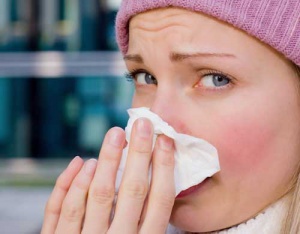Common Cold
Contents
Description
"The Common Cold"...the name says it all. Colds are both spread and contracted by people of all ages, from babies to the elderly. On the average, Americans get two to three colds per year. It's a rare individual who can honestly say that they've never experienced cold symptoms. Colds usually occur during the colder winter months, but can also be experienced during the summer. A popular expression often shared is, "there's nothing worse than a summer cold".
The common cold is a general inflammation of the mucous membranes of the respiratory passages, and is caused by a variety of viruses. The symptoms range from mild to severe, and usually start with a sore or "scratchy" throat. Nasal congestion and drainage follow, resulting in a red irritated nose. Cold sores (fever blisters) may appear from overuse of tissues or handkerchiefs. Watery eyes, headaches, chest congestion, cough and temporary loss of smell and taste are often experienced.
Causes
Colds are highly contagious, and when the body's resistance to viral infections is low, one is more suseptible to "catching" a cold. Factors which lower resistance are fatigue, overexposure to cold, recent or present infections, allergic reactions, or inhalation of irritating dust or gas. The virus is usually spread about two days before symptoms appear. Many times physical contact isn't even necessary to transmit the virus, it can travel through the air with a cough or sneeze from an infected person.
Prevention
Prevention of the common cold includes simple things such as adequate sleep and a well-balanced diet. Good hygiene practices like thoroughly washing the hands frequently is key. This should become habit especially after using public rest-rooms, touching shopping carts or hand-baskets in stores, and other common places where germs may become excessive like doorknobs or countertops. Sharing drinking glasses or utensils is never advised.
Keeping the nasal passages well hydrated, especially in areas or conditions where the air is especially dry or arid, will help to prevent cold infections. Saline nasal sprays, or homemade solutions made with filtered water, sea salt and a touch of aluminum-free baking soda will help to moisten the area. Whole-house or individual room humidifiers help regulate the condition of the air that we breathe.
Vitamins, Nutrients & Foods
Following are just some of the vitamins, nutrients and foods that may help in both the prevention and treatment of the common cold.
- Vitamin A
- Vitamin B-complex
- Vitamin B6
- Vitamin C
- Vitamin D
- Vitamin E
- Vitamin F
- Bioflavonoids
- Calcium
- Protein
- Filtered water
- Probiotics
- Garlic and onions
- Pomegranate juice
- Zinc
- Fresh vegetables
- Vitamin B5 (panthothenic acid)
- Hot tea with honey and lemon
Herbs & Alternative Therapies
Some herbs that may be effective in the prevention and treatment of the common cold are: echinacea, astragalus, goldenseal, ginseng, white willow, eucalyptus, burdock, ginkgo, chamomile, oil of oregano and red clover.
Alternative treatments for colds are homeopathy, Rife machines and colloidal silver.
Related Discussions
- Protocol for the common cold?
- The common cold/flu: what are your recommendations?
- Theory about the common cold, input?
- 10 Ways To Boost Your Immune System
- A Vitamin C Cold Cure
